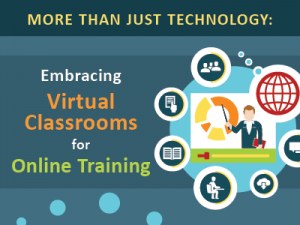How do You Establish Successful Virtual Classroom Training?
 Talk of using virtual classrooms to help businesses create blended learning environments has heated up over the past few of years.
Talk of using virtual classrooms to help businesses create blended learning environments has heated up over the past few of years.
This new reality comes as no surprise. There are numerous benefits when using virtual classroom training to complement in-person trainings (as blended learning). Businesses save money and time by bringing learners together in virtual classrooms. This includes:
-Avoiding the costs of travel
-Decreasing time spent in classroom (=decrease of spending on training)
-Reducing extraneous training costs (printing, books, etc.) with digital materials
(These examples demonstrate a monetary way of calculating the ROI of virtual training.)
Unfortunately, many businesses make the assumption that by simply purchasing a virtual classroom platform, they will reap the above benefits and more. This can leave a training department in a lurch.
Although having the right technology is key, the transition can be complicated.
A la Donald Rumsfeld, there are many “unknown-unknowns” with virtual classroom training.
The “Unknown-Unknowns” of Virtual Classroom Training
When businesses take the step toward virtual classroom training, they may be unaware of the intermingled complexity of their new modality.  They need to recognize that there are three interrelated factors:
They need to recognize that there are three interrelated factors:
-The Training Team’s understanding of the platform
-The Organization’s preparedness for virtual training
-The Organization’s recognition of learners’ needs
Perhaps a business has educated their trainers on how to use the virtual platform, but have they “virtualized” their content to drive engagement? What good is a trainer’s knowledge of the platform if they’re just going to be delivering a PowerPoint presentation? (#DeathByPPT) Moreover, has the business thought about how their learners will adapt to the online medium?
What I’ve just laid out represents one variation of numerous “unknown-unknowns” combinations. If businesses don’t address these important considerations, they may not adequately secure the benefits they desire. So what’s the strategy for overcoming these issues?
Dealing with “unknown-unknowns” begins by asking why: “Why are we using virtual classroom training?”
The Why
When you’re evaluating virtual classroom options, don’t simply calculate ROI based upon the ways you can save money. Make the decision based on a well-defined reason: why your business should use a virtual classroom!
Virtual training has the potential to make your training curriculum more dynamic than in-person sessions alone. When you blend virtual and in-person training, you provide for an enhanced learner experience. The blended learning experience has been shown to improve:
-Learners’ retention
-Workers’ productivity
-Attrition of employees
When you think about using the virtual classroom, begin by focusing your “why” on what your organizational and learner needs. Then evaluate how virtual training can make your curriculum more dynamic.
The real challenge is to get started moving in the right direction.
The First Step
Succeeding with virtual classrooms depends on making use of the right tech, plus an organizational shift in attitude and understanding. Successful implementation requires an approach unique to your business. We can help you get it all figured out.

In our webinar recording, “More than Just Technology: Embracing Virtual Classrooms for Online Training,” we discuss the strategies for making the transition to virtual classroom training a success!
After you participate in the webinar, contact our Product Specialists to learn more about how you can embrace the virtual classroom!

 Talk of using virtual classrooms to help businesses create blended learning environments has heated up over the past few of years.
Talk of using virtual classrooms to help businesses create blended learning environments has heated up over the past few of years. They need to recognize that there are three interrelated factors:
They need to recognize that there are three interrelated factors:

